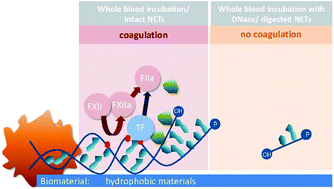当前位置:
X-MOL 学术
›
Biomater. Sci.
›
论文详情
Our official English website, www.x-mol.net, welcomes your
feedback! (Note: you will need to create a separate account there.)
Neutrophil extracellular trap formation upon exposure of hydrophobic materials to human whole blood causes thrombogenic reactions
Biomaterials Science ( IF 5.8 ) Pub Date : 2017-07-18 00:00:00 , DOI: 10.1039/c7bm00458c Claudia Sperling 1, 2, 3, 4, 5 , Marion Fischer 1, 2, 3, 4, 5 , Manfred F. Maitz 1, 2, 3, 4, 5 , Carsten Werner 1, 2, 3, 4, 5
Biomaterials Science ( IF 5.8 ) Pub Date : 2017-07-18 00:00:00 , DOI: 10.1039/c7bm00458c Claudia Sperling 1, 2, 3, 4, 5 , Marion Fischer 1, 2, 3, 4, 5 , Manfred F. Maitz 1, 2, 3, 4, 5 , Carsten Werner 1, 2, 3, 4, 5
Affiliation

|
Neutrophil extracellular trap (NET) formation, a reaction of the innate immune system to fight pathogens, was shown to be involved in thrombus formation. In the present study blood-contacting biomaterials with graded surface characteristics were investigated as a potential cause of NET formation on medical devices. Surface properties are known to govern protein adsorption, cell adhesion and ultimately the activation of several other host defense pathways – potentially also the formation of NETs. Model materials of defined hydrophilic or hydrophobic properties (glass, and thin films of poly(ethylene-alt-maleic anhydride), self-assembled monolayers of methyl terminated alkanethiols, and Teflon AF™) were incubated either with isolated human granulocytes after pre-adsorption with plasma proteins or with human whole blood. NET formation – detected as extracellular DNA, citrullinated histones, elastase and reactive oxygen species (ROS) – was observed on hydrophobic surfaces. Furthermore, NET formation on the hydrophobic surface Teflon AF™ resulted in elevated thrombin generation in hirudin-anticoagulated whole blood, but not in heparinized whole blood. Disintegration of surface-bound NETs by DNase treatment resulted in significantly lower pro-coagulant effects. Thus, NET formation can contribute to the thrombogenicity of clinically applied hydrophobic materials, suggesting NETosis as well as NET surface anchorage as new targets of anticoagulation strategies.
中文翻译:

疏水性物质暴露于人全血后形成的中性粒细胞胞外陷阱导致血栓形成反应
中性粒细胞胞外陷阱(NET)的形成是先天免疫系统抵抗病原体的一种反应,被证明与血栓形成有关。在本研究中,研究了具有渐变表面特性的血液接触生物材料,这是在医疗设备上形成NET的潜在原因。已知表面特性决定着蛋白质的吸附,细胞粘附以及最终激活了其他几种宿主防御途径,也可能影响了NET的形成。具有定义的亲水性或疏水性的模型材料(玻璃和聚乙烯(铝盐)薄膜-马来酸酐),甲基末端链烷硫醇的自组装单分子膜和Teflon AF™)与血浆蛋白预吸附后与分离的人类粒细胞或与人类全血一起孵育。NET的形成-在细胞表面观察到了胞外DNA,瓜氨酸组蛋白,弹性蛋白酶和活性氧(ROS)-的存在。此外,在疏水性表面Teflon AF™上形成的NET导致水anti素抗凝全血中的凝血酶生成升高,而肝素化全血中却没有。通过DNase处理使表面结合的NET崩解会显着降低促凝作用。因此,NET的形成可有助于临床上应用的疏水性材料的血栓形成性,
更新日期:2017-08-03
中文翻译:

疏水性物质暴露于人全血后形成的中性粒细胞胞外陷阱导致血栓形成反应
中性粒细胞胞外陷阱(NET)的形成是先天免疫系统抵抗病原体的一种反应,被证明与血栓形成有关。在本研究中,研究了具有渐变表面特性的血液接触生物材料,这是在医疗设备上形成NET的潜在原因。已知表面特性决定着蛋白质的吸附,细胞粘附以及最终激活了其他几种宿主防御途径,也可能影响了NET的形成。具有定义的亲水性或疏水性的模型材料(玻璃和聚乙烯(铝盐)薄膜-马来酸酐),甲基末端链烷硫醇的自组装单分子膜和Teflon AF™)与血浆蛋白预吸附后与分离的人类粒细胞或与人类全血一起孵育。NET的形成-在细胞表面观察到了胞外DNA,瓜氨酸组蛋白,弹性蛋白酶和活性氧(ROS)-的存在。此外,在疏水性表面Teflon AF™上形成的NET导致水anti素抗凝全血中的凝血酶生成升高,而肝素化全血中却没有。通过DNase处理使表面结合的NET崩解会显着降低促凝作用。因此,NET的形成可有助于临床上应用的疏水性材料的血栓形成性,











































 京公网安备 11010802027423号
京公网安备 11010802027423号